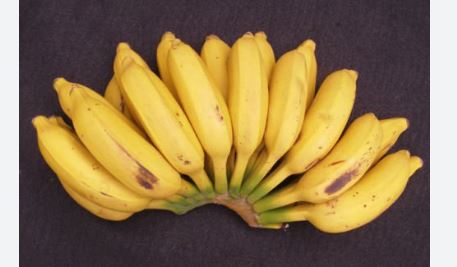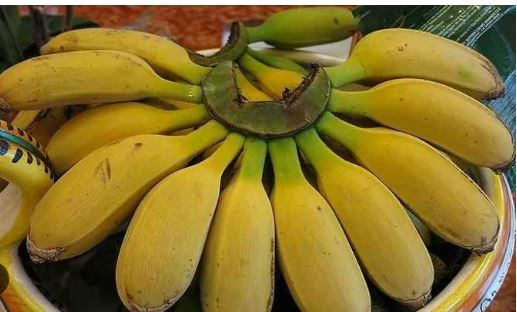
The Goldfinger Banana (Musa × paradisiaca ‘FHIA-01 Goldfinger’) is a remarkable banana cultivar celebrated for its sweet, apple-like flavor, disease resistance, and adaptability to diverse climates. Developed in Honduras as a pest-resistant alternative to the Cavendish, Goldfinger offers a unique taste, combining hints of apple, honey, and vanilla, with a creamy texture that shines in both fresh and cooked dishes.
Its robust nature and environmental benefits make it a favorite among growers and consumers seeking a sustainable, flavorful fruit. In this comprehensive guide, we’ll explore the botanical classification, history, native area, identifying characteristics, taste, growth rate, USDA hardiness zones, culinary applications, nutritional value, season availability, and a fun fact about the Goldfinger Banana.
Botanical Classification
The Goldfinger Banana belongs to the following taxonomic classification:
- Kingdom: Plantae
- Phylum: Tracheophyta
- Class: Liliopsida
- Order: Zingiberales
- Family: Musaceae
- Genus: Musa
- Species: × paradisiaca
- Cultivar: ‘FHIA-01 Goldfinger’
The Goldfinger Banana is a tetraploid (AAAB) hybrid derived from Musa acuminata (AAA) and Musa balbisiana (B), developed by the Honduran Foundation for Agricultural Research (FHIA). Its parentage includes the triploid Musa acuminata × balbisiana (AAB) cultivar ‘Prata-anã’ from Brazil and the hybrid SH-3142, which traces back to Musa acuminata (AA) cultivars ‘Pisang jari buaya’ (Papua New Guinea), ‘Lidi’ (Sumatra), ‘Sinwobogi’ (Papua New Guinea), and wild seeded Musa acuminata (Philippines). This complex genetic makeup enhances its disease resistance and flavor complexity. Goldfinger is sterile, seedless, and propagated vegetatively through suckers or tissue culture, ensuring consistent fruit quality. Its full designation is Musa acuminata × balbisiana (AAAB Group) ‘FHIA-01 Goldfinger’.
History of the Goldfinger Banana

The Goldfinger Banana was developed in the 1980s by the Honduran Foundation for Agricultural Research (FHIA) under the leadership of scientists Phillip Rowe and Franklin Rosales. The FHIA aimed to create a banana cultivar resistant to devastating diseases like black sigatoka and Panama disease (Race 4), which threatened global banana production, particularly the dominant Cavendish. The project began in 1977, with early hybrids showing resistance to burrowing nematodes and Panama disease, culminating in the release of FHIA-01 Goldfinger in 1988.
Goldfinger was unveiled in Canada in 1994 by the International Development Research Centre (IDRC), targeting Western markets as a potential replacement for Cavendish due to its superior pest resistance and flavor. Its environmental benefits, including reduced pesticide use, appealed to sustainable agriculture advocates. While it gained traction in Australia, where it’s marketed as ‘Goldfinger’, it has struggled to displace Cavendish in North America and Europe due to market familiarity and Cavendish’s longer shelf life.
The cultivar’s ancestry includes Southeast Asian and South American banana varieties, reflecting centuries of banana domestication starting around 8000 BCE in Papua New Guinea. Goldfinger’s development represents a modern milestone in banana breeding, combining traditional genetics with scientific innovation to address global agricultural challenges. Today, it’s grown in Honduras, Costa Rica, Australia, Philippines, and Hawaii, with increasing interest in subtropical regions.
Native Area
Goldfinger Bananas were developed in Honduras, but their genetic origins lie in Southeast Asia (Papua New Guinea, Sumatra, Philippines) and South America (Brazil). As a cultivated hybrid, Goldfinger has no true native area but is adapted to tropical and subtropical climates worldwide.
Key cultivation regions include:
- Latin America: Honduras, Costa Rica, Colombia
- Asia: Philippines, Thailand
- Oceania: Australia, Hawaii
- Africa: Nigeria, Ghana (limited)
Goldfinger thrives in warm, humid environments with 100–150 inches of annual rainfall or irrigation, making it suitable for equatorial and subtropical regions. Its disease resistance and cold tolerance expand its range compared to traditional bananas.
Identifying Characteristics
- Size and Shape: Goldfinger bananas are medium to large, typically 6–8 inches long and 1–1.5 inches wide, with a curved, cylindrical shape. They grow in large bunches of 6–10 hands, each with 12–20 fingers, weighing 15–30 pounds.
- Skin: The skin is thick, smooth, and green when unripe, ripening to a golden-yellow with brown speckles. The peel is slightly tougher than Cavendish, protecting the fruit during transport.
- Flesh: The flesh is creamy white to pale yellow, firm yet smooth, with a dense, creamy texture when ripe. It is seedless and occasionally has tiny black specks, remnants of sterile seeds.
- Stem: Fruits are attached to a greenish-brown stem within the hand, connecting to the main stalk. The stem is removed during harvest.
- Aroma: Goldfinger bananas have a sweet, fruity aroma with notes of apple, honey, and vanilla, intensifying as they ripen.
- Plant Characteristics: Goldfinger plants are herbaceous perennials, reaching 10–18 feet tall (dwarf varieties 8–12 feet), with broad, lush green leaves (up to 6 feet long) forming a pseudostem. The rhizome produces suckers for propagation, and the inflorescence emerges after 18–24 months, developing into fruit over 6–8 months. Plants are monocarpic, dying after fruiting, with suckers continuing the cycle. Their black stems and wavy leaves enhance ornamental appeal.
Taste
- Sweetness: Ripe Goldfinger bananas are sweeter than Cavendish, with a sugar content of 15–20%, offering a honey-like sweetness with a subtle tang.
- Tartness: The flavor includes a mild tartness, reminiscent of green apple or citrus, adding depth and balance. Unripe bananas are starchy and tangy, suitable for cooking.
- Flavor Notes: The flavor profile is tropical and multifaceted, with notes of apple, honey, vanilla, and hints of strawberry or pineapple. Some describe it as custard-like or caramel-like when fully ripe.
- Texture: The texture is creamy, smooth, and slightly dense, with a pasty yet pleasant mouthfeel, similar to Dwarf Brazilian but softer in the center. Unripe bananas are firm and starchy, ideal for frying or boiling.
- Aftertaste: The aftertaste is sweet and fruity, with a lingering apple-vanilla note that encourages another bite.
Growth Rate
- Establishment: Plants grow from suckers or tissue-cultured plantlets, producing fruiting pseudostems within 18–24 months. New leaves emerge every 7–10 days, forming a pseudostem.
- Mature Size: Plants reach 10–18 feet tall (dwarf varieties 8–12 feet) and 1–2 feet in diameter at the pseudostem, with a spread of 6–12 feet due to large leaves.
- Fruit Production: The inflorescence emerges after 18–24 months, developing into a bunch of 50–150 bananas over 6–8 months. Each plant fruits once, then dies, with suckers continuing the cycle. Harvests occur every 9–12 months in commercial settings.
- Propagation: Goldfinger is propagated vegetatively, using suckers or tissue culture to ensure disease-free, uniform plants. Tissue culture is preferred for commercial production to avoid pathogens.
USDA Hardiness Zones
- Temperature: Optimal growth occurs at 75–95°F, with fruit production slowing below 60°F. Plants tolerate brief exposure to 28–32°F, with leaves browning but rhizomes surviving for regrowth. Prolonged cold below 20°F can kill the plant.
- Sunlight: Full sun (6–8 hours daily) for vigorous growth and fruit production.
- Soil: Well-drained, fertile loam (pH 5.5–7.0) enriched with organic matter. Goldfinger requires nitrogen, potassium, and phosphorus for optimal growth.
- Climate: Tropical and subtropical climates with high humidity (60–80%) and consistent rainfall or irrigation. Goldfinger’s wind resistance suits exposed sites.
- Adaptability: Goldfinger’s cold tolerance allows growth in Zone 8 with protection (e.g., mulching, wrapping). In colder zones, grow in containers and move indoors to a bright, warm space (above 60°F). Its disease resistance to black sigatoka and Fusarium wilt reduces maintenance.
Culinary Applications
- Fresh Eating: Ripe Goldfinger bananas (vibrant yellow) are eaten fresh as a snack or dessert, offering a sweet, honeyed flavor. They’re perfect for fruit platters or lunchboxes.
- Smoothies and Beverages: Blended into smoothies, milkshakes, or sorbet, Goldfinger adds a creamy, tropical sweetness. Pair with mango, pineapple, or yogurt for vibrant drinks.
- Baked Goods: Ripe bananas are mashed into banana bread, muffins, cakes, or pancakes, enhancing sweetness and moisture. They’re ideal for banana pudding or cheesecake.
- Frozen Treats: Frozen Goldfinger bananas are used in smoothie bowls or ice cream, offering a creamy, apple-flavored base.
- Cooked Dishes: Green Goldfinger bananas are boiled, fried, or baked into chips, tostones, or savory sides, similar to plantains, with a tangy, starchy profile.
- Grilled or Caramelized: Ripe bananas are grilled or caramelized with butter and sugar, served as a dessert with ice cream or whipped cream.
- Salads: Sliced ripe bananas add sweetness to fruit salads, pairing well with citrus, berries, or nuts.
Health Benefits
- Energy Boost: High carbohydrates provide quick, sustained energy, ideal for snacks or pre-workout fuel.
- Heart Health: Potassium regulates blood pressure, while fiber lowers cholesterol levels.
- Digestive Health: Fiber promotes regular bowel movements and supports gut microbiota.
- Immune Support: Vitamin C and antioxidants strengthen immunity.
- Mood and Brain Function: Vitamin B6 supports serotonin production, enhancing mood.
- Muscle Recovery: Potassium prevents cramps, beneficial post-exercise.
Season Availability
- Harvest Season: Harvested year-round in tropical regions, with plants producing fruit every 18–24 months. Fruit takes 6–8 months to mature after flowering, typically harvested green for transport.
- Market Availability: Fresh Goldfinger bananas are available 12 months a year in local markets in Honduras, Costa Rica, Australia, and Hawaii. In North America and Europe, they’re found in specialty grocery stores, ethnic markets, or online retailers, though less common than Cavendish.
- Storage: Store green bananas at room temperature for 1–2 weeks to ripen. Refrigerate ripe bananas to extend shelf life up to 2 weeks, though peels may darken. Freeze peeled bananas for 6 months for smoothies or baking.
- Peak Quality: Ripe Goldfinger bananas (vibrant yellow) offer optimal sweetness; green bananas are best for cooking.
Fun Fact
The Goldfinger Banana, with its apple-like flavor, was once envisioned as the “banana of the future,” designed to save the industry from disease threats! In Australia, it’s a farmers’ market star, often sold as “gourmet bananas” for their honeyed taste. Growers love its toughness, joking that it laughs off storms and pests that topple other bananas. In Honduras, it’s nicknamed “el dedo de oro” (the golden finger), and locals swear a single bunch can inspire a week of creative recipes, from smoothies to fritters!
Care and Cultivation Tips for Goldfinger Banana Plants
- Planting: Plant in spring in a sunny, wind-protected site with fertile, well-drained loam (pH 5.5–7.0). Use suckers or tissue-cultured plantlets from nurseries. Dig a hole 2 feet deep and wide, enrich with compost, and plant with the rhizome base level with the soil. Space plants 4–6 feet apart.
- Watering: Water deeply (1–2 inches daily) to keep soil moist but not waterlogged. Mulch with 4–6 inches of organic material to retain moisture.
- Fertilization: Apply a high-nitrogen fertilizer (e.g., 30-10-10) monthly during the growing season, switching to high-potassium (e.g., 15-5-30) during flowering. Use 1–2 pounds per plant.
- Pruning: Remove dead leaves and spent fruit stalks. Trim suckers to maintain 2–3 per plant for future growth. Cut the fruiting pseudostem to ground level after harvest.
- Pest and Disease Control: Goldfinger resists black sigatoka and Fusarium wilt but is susceptible to yellow sigatoka and nematodes. Monitor for pests like banana weevils and apply neem oil or fungicides as needed.
- Support: Prop heavy fruit bunches with bamboo poles to prevent toppling. Cover bunches with plastic bags to protect from pests.
- Winter Protection: In Zone 8, mulch heavily (6–12 inches) and wrap pseudostems with burlap during cold snaps. In colder zones, grow in containers and move indoors to a bright, warm space (above 60°F).
Challenges and Considerations
- Market Acceptance: Goldfinger struggles to compete with Cavendish in Western markets due to consumer familiarity and shelf-life differences.
- Disease Vulnerability: While resistant to black sigatoka and Fusarium wilt, it’s susceptible to yellow sigatoka and nematodes, requiring vigilant management.
- Cold Sensitivity: Prolonged cold below 28°F damages plants, limiting outdoor cultivation in cooler zones without protection.
- Ripening Time: Goldfinger takes longer to mature (6–8 months), requiring patience compared to faster-maturing cultivars.
- Availability: Limited commercial distribution outside tropical regions makes sourcing challenging, often requiring home cultivation.